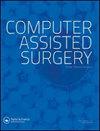A computer-assisted navigation technique to perform bone tumor resection without dedicated software
IF 1.9
4区 医学
Q3 SURGERY
引用次数: 1
Abstract
Abstract Purpose: In oncological orthopedics, navigation systems are limited to use in specialized centers, because specific, expensive, software is necessary. To resolve this problem, we present a technique using general spine navigation software to resect tumors located in different segments. Materials and Methods: This technique requires a primary surgery during which screws are inserted in the segment where the bone tumor is; next, a CT scan of the entire segment is used as a guide in a second surgery where a resection is performed under navigation control. We applied this technique in four selected cases. To evaluate the procedure, we considered resolution obtained, quality of the margin and its control. Results: In all cases, 1 mm resolution was obtained; navigation allowed perfect control of the osteotomies, reaching the minimum wide margin when desired. No complications were reported and all patients were free of disease at follow-up (average 25.5 months). Conclusions: This technique allows any bone segment to be recognized by the navigation system thanks to the introduction of screws as landmarks. The minimum number of screws required is four, but the higher the number of screws, the greater the accuracy and resolution. In our experience, five landmarks, placed distant from one another, is a good compromise. Possible disadvantages include the necessity to perform two surgeries and the need of a major surgical exposure; nevertheless, in our opinion, the advantages of better margin control justify the application of this technique in centers where an intraoperative CT scanner, synchronized with a navigation system or a dedicated software for bone tumor removal were not available.一种计算机辅助导航技术,在没有专用软件的情况下进行骨肿瘤切除术
目的:在肿瘤骨科中,导航系统仅限于在专业中心使用,因为需要特定的、昂贵的软件。为了解决这个问题,我们提出了一种使用一般脊柱导航软件切除位于不同节段的肿瘤的技术。材料和方法:该技术需要进行一次初级手术,在骨肿瘤所在的部分插入螺钉;接下来,整个节段的CT扫描作为第二次手术的指导,在导航控制下进行切除。我们在四个选定的病例中应用了这种技术。为了评价该方法,我们考虑了所获得的分辨率、边缘质量及其控制。结果:所有病例均获得1 mm分辨率;导航可以完美地控制截骨术,在需要时达到最小的宽缘。随访(平均25.5个月),无并发症报告,所有患者无疾病。结论:由于引入螺钉作为标志,该技术允许导航系统识别任何骨段。最少需要四个螺钉,但螺钉数量越多,精度和分辨率越高。根据我们的经验,五个地标,彼此相距较远,是一个很好的妥协。可能的缺点包括需要进行两次手术和需要进行大手术暴露;然而,在我们看来,更好的边缘控制的优势证明了在术中CT扫描仪与导航系统同步或骨肿瘤切除专用软件不可用的中心应用该技术是合理的。
本文章由计算机程序翻译,如有差异,请以英文原文为准。
求助全文
约1分钟内获得全文
求助全文
来源期刊

Computer Assisted Surgery
Medicine-Surgery
CiteScore
2.30
自引率
0.00%
发文量
13
审稿时长
10 weeks
期刊介绍:
omputer Assisted Surgery aims to improve patient care by advancing the utilization of computers during treatment; to evaluate the benefits and risks associated with the integration of advanced digital technologies into surgical practice; to disseminate clinical and basic research relevant to stereotactic surgery, minimal access surgery, endoscopy, and surgical robotics; to encourage interdisciplinary collaboration between engineers and physicians in developing new concepts and applications; to educate clinicians about the principles and techniques of computer assisted surgery and therapeutics; and to serve the international scientific community as a medium for the transfer of new information relating to theory, research, and practice in biomedical imaging and the surgical specialties.
The scope of Computer Assisted Surgery encompasses all fields within surgery, as well as biomedical imaging and instrumentation, and digital technology employed as an adjunct to imaging in diagnosis, therapeutics, and surgery. Topics featured include frameless as well as conventional stereotactic procedures, surgery guided by intraoperative ultrasound or magnetic resonance imaging, image guided focused irradiation, robotic surgery, and any therapeutic interventions performed with the use of digital imaging technology.
 求助内容:
求助内容: 应助结果提醒方式:
应助结果提醒方式:


